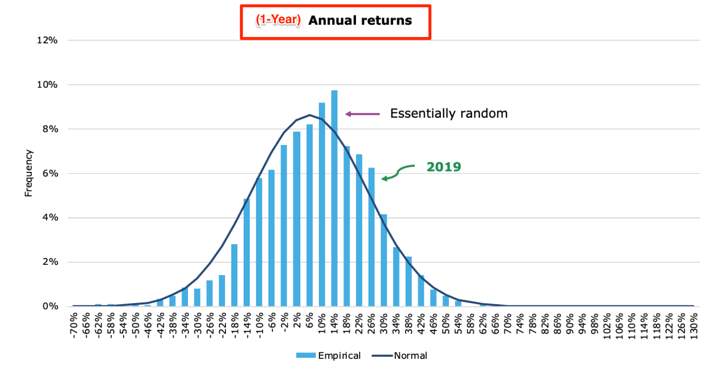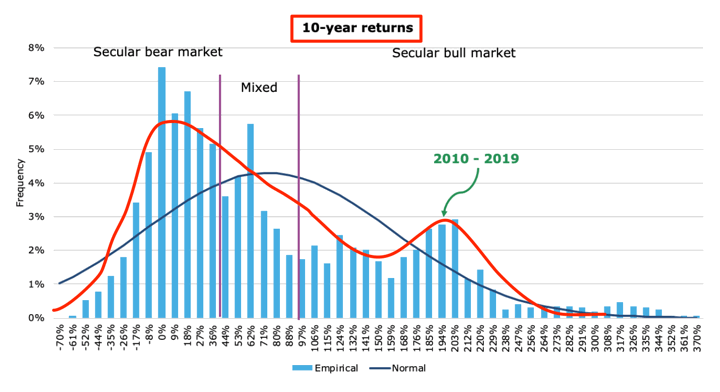[Programming note: This week is our Spring Break, so I have scheduled some interesting charts that I’ve put aside as they provided interesting “food for thought”. Comment moderation and e-mail replies will be delayed.]
Here is an interesting observation from Klement on Investing. If we chart the frequency of annual (1-year) returns of the S&P 500 index, we get something familiar and close to a (statistically) normal distribution around the average of about 10% (red added by me):

However, if we chart the frequency of the 10-year annual returns of the S&P 500, we see slightly different behavior (red added by me). Klement notes a “trimodal” distribution, but I still see two main peaks. Over this longer timeframe, we see clumping around periods of “bear markets” and “bull markets”.

The big hump on the left is marked “secular bear market”. Note that anything between -35% and +35% in a 10-year return works out to between -3% and +3% annualized. Not much movement. Meanwhile, the other big hump on the right is spread out between +100% to +300%. That means you end up with somewhere between double and quadruple your initial amount, with the peak of the “secular bull market” hump around triple.
This post is from early 2020, and we know that we had a big crash and even bigger recovery in the markets since then. For the most part though, our current secular bull market kept going for all of 2021. Klement closes with a warning:
However, we need to be aware that while the last decade was a run of the mill secular bull market, this also means that the next decade will likely be a mixed period where we experience the tail end of the current secular bull market and the front end of the next secular bear market. Why? Because there has not been a single secular bull market in history that has lasted for two full decades. We know that the current bull market is already the longest bull market in history so it is only reasonable to assume that it will end sometime in the next decade. And then, we should expect that market returns move into the mixed zone of mediocre returns.
My takeaway is that we have to be prepared for some prolonged streaks. Averages can be deceiving. Some people expect a crash after just a few good years, but often we should just ride that wave. At the same time, we need to expect and prepare to survive periods of stagnation (not the same as permanent capital loss).
 The Best Credit Card Bonus Offers – 2025
The Best Credit Card Bonus Offers – 2025 Big List of Free Stocks from Brokerage Apps
Big List of Free Stocks from Brokerage Apps Best Interest Rates on Cash - 2025
Best Interest Rates on Cash - 2025 Free Credit Scores x 3 + Free Credit Monitoring
Free Credit Scores x 3 + Free Credit Monitoring Best No Fee 0% APR Balance Transfer Offers
Best No Fee 0% APR Balance Transfer Offers Little-Known Cellular Data Plans That Can Save Big Money
Little-Known Cellular Data Plans That Can Save Big Money How To Haggle Your Cable or Direct TV Bill
How To Haggle Your Cable or Direct TV Bill Big List of Free Consumer Data Reports (Credit, Rent, Work)
Big List of Free Consumer Data Reports (Credit, Rent, Work)
Speak Your Mind